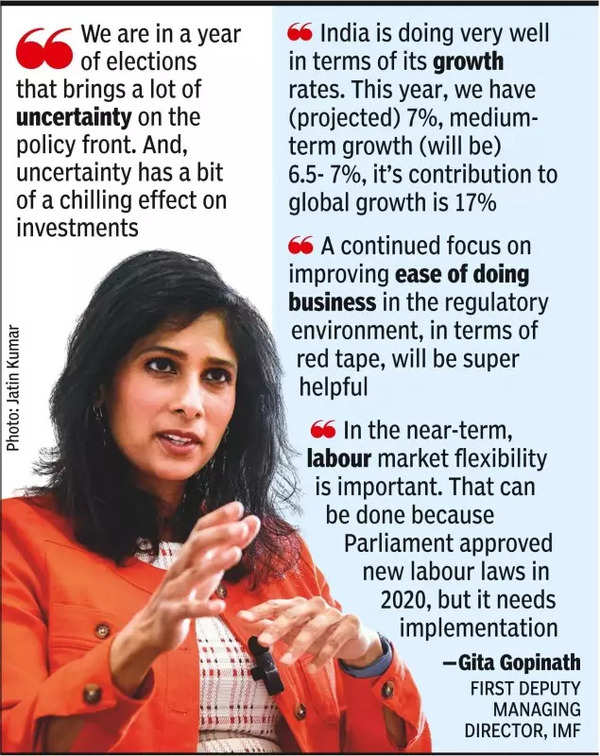
How do you see wars and crises affecting the world and India?
In the last few years, we have seen a big rise in geo-political uncertainty, that’s a reflection of the conflicts, Russian invasion of Ukraine, conflicts in the Middle East (West Asia). More generally, because of the pandemic and the war. there has been a rethinking by countries of what should be the rules of engagement. It’s not always efficiency driven, but also driven by resilience, national security concerns. This is a very different environment from what we have lived in over the last three decades in terms of global integration.
In the short term, the energy crisis that came after the war and the food insecurity fed into much higher cost of living in countries. But given that these conflicts remain, we could see a further increase, for example, in oil prices, which will have negative implications for many countries, including for India. The other aspect is just uncertainty. We are in a year of elections that brings a lot of uncertainty on the policy front. And uncertainty has a bit of a chilling effect on investments.
Trade fragmentation is a serious concern. In 2022 and 2023 there were around 3,000 new trade restrictions that were put in place. We are seeing a lot of industrial policies in countries that are also tied to trade restricting measures grow. Countries that are geopolitically close are seeing trade hold up much better than countries that are geopolitically distant. We are still in the early stages of geo economic fragmentation. The risk of causing this could become much more severe, in which case there are no winners.
Will it be difficult for countries like India to grow faster given that China, Korea or Japan had more favorable conditions?
Trade has been an engine of growth for countries, and there’s also been a lot of desire for reshoring production that affects the ability for other developing countries to benefit from trade. One of the political consequences is that countries are looking for other trade partners, they want to diversify. So being purely efficiency driven with focusing on one trade partner is now considered risky, which presents its opportunities to countries like India, because India is viewed favorably as a country to work with.
It is very important for India and other nations to ensure that we have a well-functioning, multilateral, -based system.
India is doing very well in terms of growth. But is it getting carried away by the growth hype?
India is doing very well in terms of its growth rates. This year we have (projected) 7%, medium term growth (will be) 6.5- 7%; its contribution to global growth is 17%. It is one of the fastest growing major global economies in the world. To get to even higher growth numbers, to keep up the momentum, it would require a very strong reform agenda, that’s something the government is working on.

What would be your prescription or your suggestions on the reform agenda?
The 7% growth is coming along with not as much employment creation, and that’s an area where attention needs to be given. If you look at investment, private investment, you’re seeing private investment strong in the household sector and real estate. But if you look at, say, investment in machinery and equipment, that’s not as strong.
First, a continued focus on improving the ease of doing business in the regulatory environment, in terms of red tape, will be super helpful. We studied where did foreign direct investment go in India. Two states that stand out are Gujarat and Tamil Nadu, and the other states that also rank very well in terms of business climate.
In the near term, labor market flexibility is important. That can be done because parliament approved new labor laws in 2020, but it needs implementation, and that’s going to require regulations in the states. It’s going to require incentivizing the states to implement these laws.
India’s tariff rates are higher than for its peers. If India wants to be part of the global supply chains. Being part of global supply chains, you have to have fairly inexpensive importing and exporting in the absence of that it is going to be hard to attract investment into the country.
If you look at foreign direct investment in India, there is a lot of interest. You look at announced projects, we’re looking at large numbers, like $80 billion worth of projects. India’s opening up in being able to have fewer trade restrictions will help bring this investment in. Last, something the government has done really well is investing in public infrastructure, both the physical and the digital. But India is still an economy that needs a lot more, and the budget has put in additional funding for public investment.
Then there is a more medium term. Increasing levels of education, increasing skilling, including digital digital skills, are going to be important. Second, agricultural sector reforms are going to be important.
What are your views on the policy of incentivizing the private sector to create jobs?
It’s certainly a measure that has been and tested. Incentives help. There is the employment linked incentive that was part of the budget that certainly is addressing the problem. As with all policies, it’s important at some point to do a cost-benefit analysis. We crunched some numbers and additional jobs that need to be created between now and 2030 cumulatively ranges between 60 million and 148 million. To get that kind of job creation to happen, it will require broad based reforms.
How big is this challenge coming from artificial intelligence? How does it impact future job creation? There have been suggestions of a robot tax to create a social security buffer.
There are risks. First, AI, as always, with general purpose technologies, offers the promise of raising productivity growth, which in general is good for jobs and for productivity. But on the other hand, given the nature of this technology, the risks in terms of displacing labor are also there. There is a lot of uncertainty about all of these numbers. Some estimates are close to zero, and some of them are very large. It depends upon how quickly this can be adapted into the economy.
We have our own study; on average, for the world, about 40% of jobs are exposed to AI. That doesn’t mean it’s a bad thing, about half that are complemented by AI and half that are substituted by AI. So the impact can be quite large, depending upon how this technology develops.
In terms of the question of what this implies for taxation, first, all policy makers should be paying pretty close attention to how AI is developing and being adopted, because it has implications on multiple fronts. There is a regulatory aspect of it, the technology being used ethically, and data disclosures being respected.
AI tax depends on the specifics. Whether there should be a (robot) tax, our view is, no because we believe in efficiency and in productivity. But that said, it is helpful for governments around the world, to look at their tax structures, because you could actually end up incentivizing automation in a direction right now. Sometimes you may incentivize it for good reasons, but sometimes it’s just that you haven’t paid enough attention, and your marginal effective tax rate is much lower for automating than for hiring a worker. We have done some analysis that shows that is indeed the case. There are countries, especially some advanced economies, where it seems to be more favoring automation and away from labor.
Can billionaire tax and wealth tax be effective in dealing with inequality?
The IMF is in favor of a progressive tax structure. We think better implementation of what’s there in terms of capital income taxes, property taxes can be encoded into the tax system properly. With wealth taxes, there are some additional complications. For example, for a lot of people, wealth is basically their home. There are implementation issues associated with it, but if you can get capital income tax, well, well done.
Would you advocate a universal basic income for a country like India?
If you are truly universal it means everybody, (and) that’s very costly for countries. So, either you give everybody extremely little, in which case, it doesn’t really have an impact. Or, if you give them a meaningful amount, it is a very large amount of money. So, it is fiscally large. The point is to do this in a much more targeted fashion, as many countries do, but that’s something that we have seen is if you increase the generosity of unemployment insurance.







